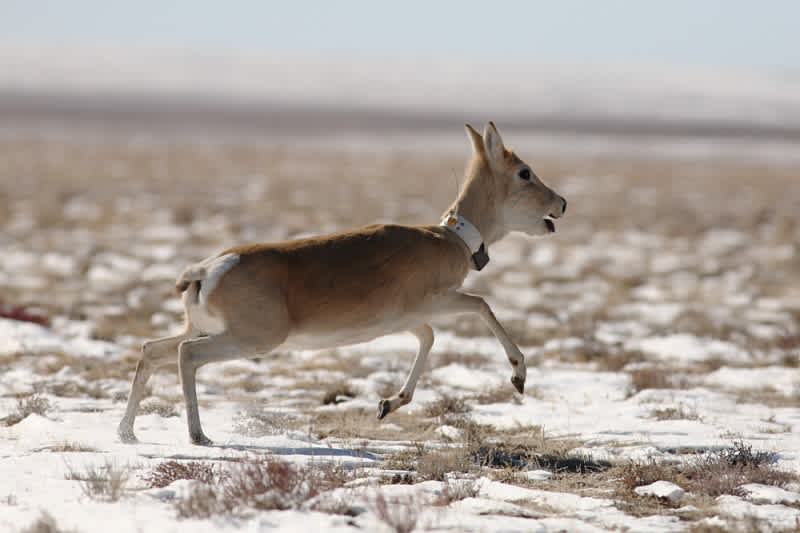Livestock, Not Mongolian Gazelles, Drive Foot-and-Mouth Disease Outbreaks
OutdoorHub Reporters 01.30.12

Mongolia’s Eastern Steppe has seen a periodic outbreak of foot-and-mouth disease for over a decade now. Foot-and-mouth disease (FMD) is a highly contagious, acute, viral disease that affects most ruminant and porcine species. Contraction of the virus causes a high fever for the first few days and blisters inside the mouth and on the feet that may be fatal to the animal or may leave the animal lame.
In a recently released study on the topic in the Journal of Wildlife Diseases, researchers suggest that it is not gazelles that carry and introduce a spread of the disease to livestock, but that the disease spills over to the gazelle population after an outbreak in livestock.
Through e-mail, I spoke to Damien Joly, Ph.D, who is a wildlife epidemiologist for the Wildlife Conservation Society. Joly said the gazelles have been a common scapegoat for the disease’s outbreak since FMD was re-introduced in Mongolia in 2000. “Gazelles have often been ‘blamed’ by some parties as the main species spreading the disease, leading to calls for culling of gazelles and/or fencing to stop their migration,” Joly said.
“Our research suggests that the virus is not harbored in the gazelle population between outbreaks, and so control of the virus in livestock is the most effective way to stop outbreaks.”
While the disease is not considered a threat to human health, Joly said it has a detrimental economic impact on a community. “An outbreak of FMDV in a country results in trade barriers being put up so that an affected country can’t export live animals, meat, or other livestock products.”
Americans in the USA do not need to worry about the disease spreading from Mongolia to the states as Mongolian livestock/meat does not enter the United States. But international aid from the United States and other countries to Mongolia might be necessary to curb spread of foot-and-mouth disease. Joly said the keys to control FMD include traditional means like good surveillance and adequate vaccination of livestock.
“In low-income countries like Mongolia, international aid may be necessary to make this happen. In many countries, there have not been good matches between available vaccines and the actual strain(s) of FMD circulating, which has frustrated control efforts.”
Original press release issued by the Wildlife Conservation Society on January 30th, 2012:
Wildlife health experts from the Wildlife Conservation Society have published evidence which supports the conclusion that Mongolian gazelles—one of the most populous large land mammals on the planet—are not a reservoir of foot-and-mouth disease (FMD), a highly contagious viral disease that threatens both wildlife and livestock in Asia.
Outbreaks of FMD in Mongolia affect domestic sheep, goats, camels, and cattle as well as Mongolian gazelles. In a country where roughly one-third of the human population relies directly on livestock production for their subsistence, outbreaks of FMD cause severe disruption of the rural economy.
The study, titled “Serosurveillance for Foot-and-Mouth Disease in Mongolian Gazelles (Procapra gutturosa) and Livestock on the Eastern Steppe of Mongolia,” appears in the January edition of the Journal of Wildlife Diseases. The authors include: Sanjaa Bolortsetseg, Shiilegdamba Enkhtuvshin, Wendy Weisman, Amanda Fine, Angela Yang, and Damien Joly of the Wildlife Conservation Society; and D. Nyamsuren of the Dornod Aimag Veterinary Laboratory, Choibalsan, Dornod Province, Mongolia.
The Mongolian gazelle is a medium-sized antelope with a heart-shaped patch of white fur on its rump. The species gathers in vast migratory herds across Mongolia’s Eastern Steppe, considered the largest intact temperate grassland in the world. The gazelle is under pressure from a variety of threats, particularly exploration for oil, gas, and minerals.
The research culminates a decade-long effort to examine the potential role of the gazelles in FMD ecology. In the recently published study (undertaken between 2005-2008), the research team collected blood samples from 36 gazelle calves and 57 adult gazelles in order to determine the prevalence of antibodies to the foot-and-mouth virus (FMDV). The team also collected samples from domestic animals kept in areas frequented by gazelles, including 138 sheep, 140 goats, 139 Bactrian camels, and 138 cattle for comparison.
The authors found that the patterns of FMDV antibody prevalence in gazelle populations reflect the dynamics of FMD in livestock across the Eastern Steppe of Mongolia. During 1998-99 (outbreak free years in livestock), researchers detected no antibodies in gazelles; conversely, during a FMD outbreak in livestock in 2001, researchers detected a 67 percent prevalence rate in gazelles. The recently published study examines the following outbreak free periods, during which the team noted a declining prevalence in FMDV antibodies in the gazelle population. Based on these observations, the authors conclude that the Mongolian gazelle population is not a reservoir for FMDV on the Eastern Steppe of Mongolia, but rather, the virus enters the gazelle population after spillover from livestock during sporadic outbreaks.
“The successful control of foot-and-mouth disease on the Eastern Steppe will require a program that focuses on livestock populations and entails health monitoring and vaccinations of domestic animals when needed,” said WCS veterinary epidemiologist and co-author Shiilegdamba Enkhtuvshin.


